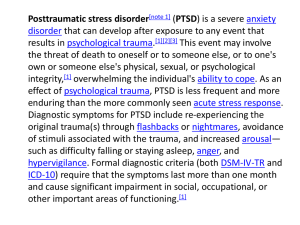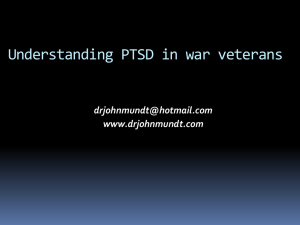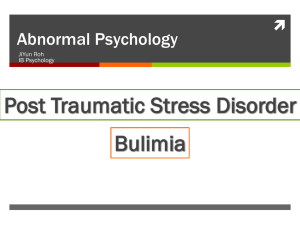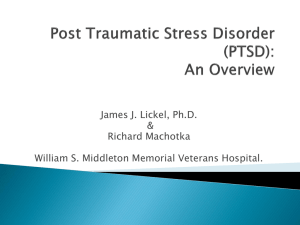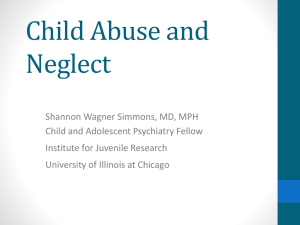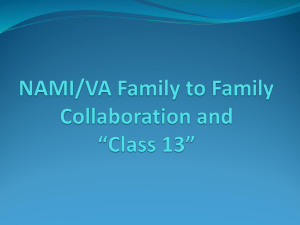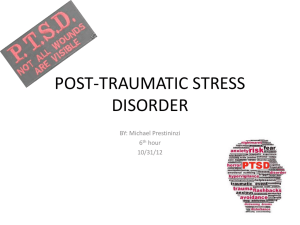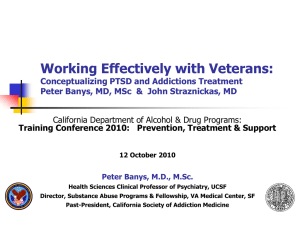Supervision!! Amy W. Wagner, Ph.D.
advertisement
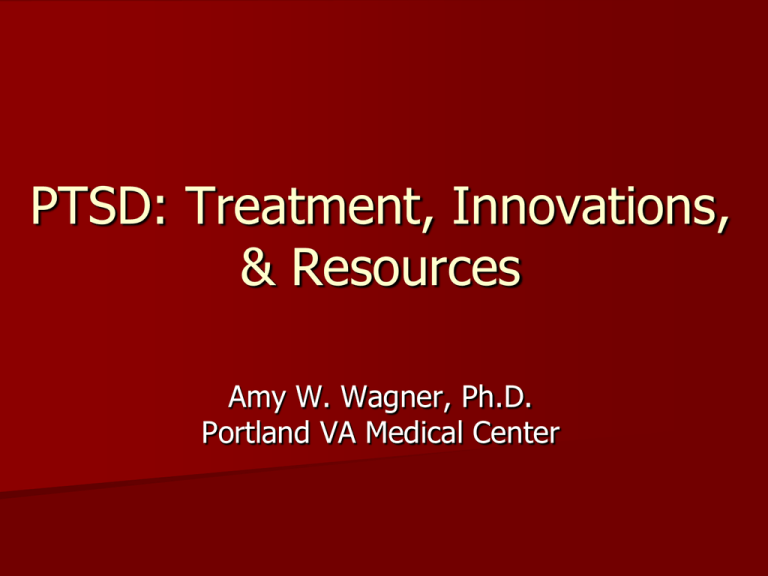
PTSD: Treatment, Innovations, & Resources Amy W. Wagner, Ph.D. Portland VA Medical Center My Plan Provide brief overview of DSM-V criteria for PTSD Discuss evidenced-based treatments for PTSD and related problems Highlight key on-line resources for you and your clients and cool innovations DSM-V “Just when I thought I knew what I was doing it all changed again…” Not so much, really. Main Changes in DSM-V for PTSD PTSD moved from the anxiety disorders to a new class, “trauma and stressor-related disorders” Definition of “trauma” slightly changed – No longer need “fear, helplessness, or horror” (A2) – Types of trauma (A1) somewhat narrowed (no longer can include unexpected death of family/close friend due to natural causes) Main Changes in DSM-V for PTSD The – – – – 3 clusters of DSM-IV are now 5 clusters: Intrusions Avoidance Negative alterations in cognitions and mood Alterations in arousal and reactivity New subtype: with dissociative symptoms Treatments for PTSD Treatments for PTSD Trauma-processing treatments – Facilitate the “working through” of traumatic experiences – Trauma-focused Skills-based treatments – Teach strategies for managing individual symptoms of PTSD – Present-focused (v. trauma-focused) Acceptance-oriented treatments – Newer to the field – Facilitate “living with” or “living despite” PTSD; i.e., living PTSD: Trauma-Processing Treatments Prolonged Exposure Therapy (PE; Foa, Hembree, & Rothbaum, 2007) Cognitive Processing Therapy (CPT; Resick & Schnicke, 1993) Eye Movement Desensitization and Reprocessing Therapy (EMDR; Shapiro, 2001) Prolonged Exposure Based on emotional processing theory (combines classical conditioning theory and an “information processing model” that links associations between stimuli, responses and meaning elements (beliefs) The fear “network” must be activated and new associations must be learned to the conditioned stimuli Prolonged Exposure Case Formulation classically conditioned response (associate related things to the trauma, e.g. loud noises, helicopters, crowded places) negative thinking (the world is dangerous, I’m incompetent) arousal (heart racing, sweatiness) avoidance (of activities, work, open spaces, crowds) PE: Fear Reduction Process to feareliciting stimuli or memories Prevention of avoidant behaviors Incorporation of new information Anxiety increases initially, followed by reduction Fear Approach Time Prolonged Exposure 9-12 90-minute sessions Education and orientation Imaginal exposure (exposure to the memories) In vivo exposure (exposure to avoided situations and activities) Stress tolerance and cognitive restructuring throughout Between session practice Cognitive Processing Therapy Largely based on a social-cognitive theory that suggests trauma alters beliefs in 5 key areas: safety, trust, power/control, esteem, & intimacy Emphasis on reconciling pre-existing beliefs with new beliefs towards more balanced ways of viewing oneself, others, and the world Like PE, views activating the “fear network” important Cognitive Processing Therapy Can be delivered individually, in group, or both 12 60-minute sessions (individual) Education and orientation Written “impact statement” Written trauma account Cognitive restructuring Between session homework Cognitive Processing Therapy Two versions, full CPT and CPT without the written trauma narrative (“CPT-C”) New data suggest CPT-C just as effective in the long run with quicker change in the short run Stay tuned! PTSD: Trauma Processing Therapies Recommended if: – Reasonable emotion regulation abilities – Motivated for treatment – Willing to focus on trauma Not recommended if: – – – – Active substance dependence High HI or SI Other indicators of significant emotion dysregulation Factors that would interfere with adhering to the treatment Pause for Plug The National Center for PTSD (VA) has a wealth of invaluable and up-to-date resources for providers and clients: http://www.ptsd.va.gov/ Why should we consider a different approach to PTSD treatment? Substantial drop-out among trauma-focused treatments Barriers exist to engagement in trauma-focused treatments Some populations show preferences for presentfocused/skill-based interventions (Veterans, adolescents) Barriers exist to implementation of traumafocused treatments PTSD: Skills-Based Treatments Based on premise that given the impact of trauma, existing means of coping are inadequate Person must learn new means of managing thoughts/memories, emotions, and behaviors Interventions are presented didactically, often in group formats Data: Main PE outcome studies actually support present-focused treatments From: Foa, EB, Dancu, CV, Hembree, EA, et al. (1999). A comparison of exposure therapy, stress inoculation training, and their combination for reducing posttraumatic stress disorder in female assault victims. JCCP, 67, 194-200. Data: Main PE outcome studies actually support present-focused treatments From: Schnurr, PP, Friedman, MJ, Engel, CC, Foa, EB, et al. (2007). Cognitive behavioral therapy for posttraumatic stress disorder in women: A randomized controlled trial. JAMA, 297, 820-830. PTSD: Skills-Based Treatments Stress Inoculation Training (Meichenbaum, 1985) Portland VAMC (Campbell, Powch, Van Male, Sardo) Other approaches (e.g., Whealin, 2008a and 2008b; VAPIHCS) PTSD: Skills-Based Treatments Individual Symptoms Anger Chronic pain Insomnia “Stress” Panic Interpersonal difficulties Avoidance PTSD: Skills-Based Treatments Often suggested as a “first step” treatment Recommended for veterans who may not be able to fully engage in trauma processing therapies Recommended for therapists who have not been trained in trauma processing therapies Acceptance-Oriented Treatments Based on premise that significant suffering stems from efforts to avoid or deny experiences and emotions Teach methods for living with (PTSD) and other intense emotional experiences towards living life more fully Teach the capacity for living in the present moment, the opposite of focusing on past traumatic experiences or potential future threats Acceptance-Oriented Treatments Dialectical Behavior Therapy (DBT; Linehan, 1993) Acceptance and Commitment Therapy (ACT; Hayes, Strosahl, & Wilson, 1999; Walser & Westrup, 2007) Acceptance-Oriented Treatments: Dialectical Behavior Therapy Comprehensive treatment for multi-problemed individuals with severe emotion dysregulation Behavior therapy at the core with strong emphasis on acceptance-based interventions (such as validation and mindfulness) Particularly effective at reducing suicidal behavior Acceptance-Oriented Treatments: Dialectical Behavior Therapy Weekly individual and skills-based group therapy, plus phone consultation and therapist support For those with “complex” presentations in which uniform case formulation does not fit Interesting new data on embedding PE within DBT for individuals with co-morbid PTSD (Harned & Linehan, 2008; Harned et al., 2012) Acceptance-Oriented Treatments: Acceptance and Commitment Therapy 12 sessions Increasing awareness: of one’s thought processes, experiences, values, and the present moment Committed action: towards what matters (and despite what one thinks and feels) Support for efficacy with depression, psychosis, substance abuse; being used with PTSD Acceptance-Oriented Treatments For those who cannot tolerate pure changeoriented treatments For those who still have some degree of suffering after trauma-processing therapies For those who do not wish to engage in trauma processing therapies For relapse prevention For anyone wanting to live life more fully in the present Behavioral Activation For Depression and PTSD (Martell, Addis, & Jacobson; Jakupcak & Wagner; Acierno et al.) Based on premise that problems in vulnerable individuals' lives and behavioral responses reduce ability to experience positive reward from their environments Aims to systematically increase activation such that patients may experience greater contact with sources of reward in their lives and solve life problems Focuses directly on activation and on processes that inhibit activation, such as escape and avoidance behaviors and ruminative thinking Resources & Innovations National Center for PTSD http://www.ptsd.va.gov/ Afterdeployment.org (self-help for veterans and family members and materials for providers) http://www.afterdeployment.org/ Resources & Innovations National Center for Telehealth and Technology http://t2health.org/ Great apps!! For clients and providers http://www.ptsd.va.gov/public/pages/PTSDCoa ch.asp http://t2health.org/apps/provider-resilience Resources & Innovations Portland Vet Center PTSD Clinical Team at the Portland VA Telehealth through the Portland VA Returning Veterans Project (http://www.returningveterans.org/index.php) Some options for “fee basis” reimbursement through the VA
